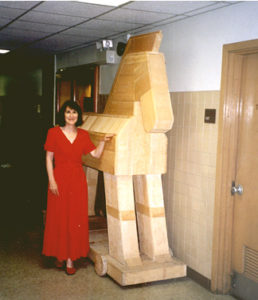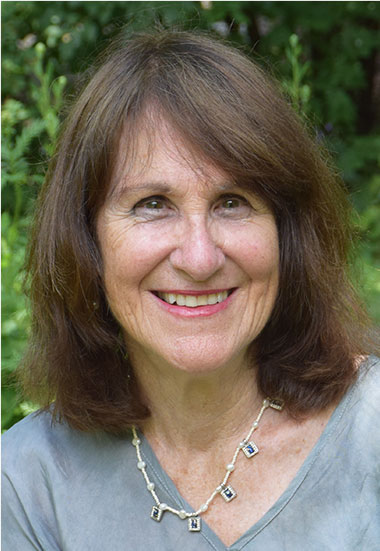Margaret George writes biographical novels about outsized historical characters: Henry VIII, Mary Queen of Scots, Cleopatra, Mary Magdalene, Helen of Troy, and Elizabeth I. Her latest, The Confessions of Young Nero, will be published in March. All six of her novels have been New York Times bestsellers, and the Cleopatra novel was made into an Emmy-nominated ABC-TV miniseries.
She especially enjoys the research she has done for the novels, such as racing in an ancient Greek stadium, attending a gladiator training school in Rome, and studying the pharmacology of snake poison.
More About Margaret

Margaret George is a rolling stone who has lived in many places, beginning her traveling at the age of four when her father joined the U.S. diplomatic service and was posted to a consulate in Taiwan. The family traveled on a freighter named after Ulysses’ son Telemachus that took thirty days to reach Taiwan, where they spent two years. Following that they lived in Tel Aviv (and visited other places in the Middle East), Bonn and Berlin (during the spy-and-Cold-War days) before returning to Washington DC where Margaret went to high school. In Israel Margaret, an avid reader, began writing novels to amuse herself when she ran out of books to read. Neither of her youthful sagas got published, but the ten-year-old author received an encouraging note from an editor at Grosset & Dunlap, telling her she had a budding talent but should work on her spelling. It was also in Israel as a child that Margaret started keeping land tortoises as pets, an interest which she still follows today.

She had a great affinity for animals and nature and that led her to a double major at Tufts University in English literature and biology. Following that she received an MA in ecology from Stanford University—one of the earliest departments to offer such a concentration. Today she is active in environmental and animal conservation groups. Combining her interests led her to a position as a science writer at the National Cancer Institute (National Institutes of Health) in Bethesda, Maryland for four years. Her marriage at the end of that time meant moving, first to St. Louis, then to Uppsala, Sweden, and then to Madison, Wisconsin, where she and her husband Paul have lived for more than thirty years now. They have one grown married daughter who lives in Washington DC. Through all this Margaret continued to write, albeit slowly and always on only one project at a time. It was in St. Louis that she suddenly got the idea of writing a ‘psycho-biography’ of Henry VIII. She had never seen such a thing done but became convinced the king was a victim of bad PR and she should rescue his good name. Her background in science meant that only after thoroughly researching the literature and scholarship on Henry VIII would she embark on the novel itself. She sought the guidance of a Tudor historian at Washington University for a reading list, and proceeded from there. It was actually fourteen years between her initial idea and the publication of The Autobiography of Henry VIII. The book made an impression for several reasons: first, because no one had ever written a novel sympathetic to the king before; second, because it covered his entire life from before birth until after his death, and third, because it was so fact-filled. It continues to be the only book about his entire live, and the only one sympathetic to him. It has been in print twenty five years now.

Following Henry VIII in 1986, she wrote Mary Queen of Scotland and the Isles (1992) and The Memoirs of Cleopatra (1997.) The Memoirs of Cleopatra was made into an ABC miniseries in 1999, starring Timothy Dalton and Billy Zane. It has been translated into nineteen languages, including Finnish and Korean. Mary Called Magdalene was published in 2002, and in 2006 she had two new books: Helen of Troy and an illustrated children’s book featuring her pet tortoise, Lucille Lost. What started as an offhand idea has blossomed into a way of life—becoming a biographer and spokesperson for those whom history has misunderstood. She chooses people that appeal to her rather than having a specific agenda, but because of the years of intense scholarly research required, she must limit herself to subjects either in the ancient world or in renaissance Britain. Each subject leads her to explore places and meet people she would not have access to otherwise, and that means that each book is an adventure in itself. It is fun to see how each of these characters are a part of popular culture. Here is a photo of a Trojan horse built as an elementary school project.
Margaret’s family is of Scots/English/Irish background; one branch were Quakers who came to America in the early 1700s. Another side of the family settled in Mississippi. The patriarch of this branch was known as “Hard Money Scott” because he always demanded cash for purchases and paid in hard cash himself. Supposedly Tories captured him during the Revolutionary War and held his feet over a fire to get him to reveal where his money was hidden, but the old skinflint refused and ended up with burnt feet but with his Scott Treasure intact. He had buried it near Scott’s Ferry in South Carolina and the family legend is that it’s still there. Today it’s under a dam. If it’s there at all… Margaret was born in Nashville, Tennessee. Her parents shared the love of words, ballads, and story-telling associated with the south; her father came from a town near Oxford, Mississippi, where Faulkner lived and wrote “the past is never gone, it’s not even past”. He was an eloquent speaker and writer and when she read Cicero’s description of Caesar’s writing—‘his vocabulary is so varied and yet so exact’ she knew he could have been describing her father as well. She dedicated Mary Queen of Scotland and the Isles to him.
Take a Tour of the Circus Maximus with Margaret

Margaret and several other authors have created dramas set in historical sites for BARDEUM audioguides. Margaret’s takes place in the Circus Maximus in Rome. Visit her page at BARDEUM for more information.

